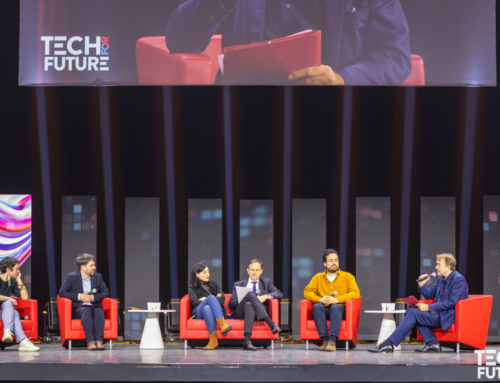Pandemic, variant, hybridization – these are the words we’ve all read and heard far too often in 2021. And there’s no reason to imagine their sudden disappearance. For all that, the mission of universities remains intact, while the expectations of a student population battered by the health crisis and isolation are as high as ever. To learn and learn better, to face the world of tomorrow, to express their talents and propose their ideas to all the players in our societies. That’s what everyone is looking forward to. These are the driving forces behind the progress of schools, teachers and EdTech companies who are working together to imagine the solutions of the future.
We meet these players on a daily basis, and our exchanges with them enrich us every day. They enable us to discover the innovations, uses and challenges that can change the world of higher education and bring about changes in teaching methods.
In 2022, we believe that 5 major trends will be at the heart of the conversations and projects of the key players in higher education and research.
1 – Immersive Learning or the AR/VR essential
At a time when everyone is talking about the metaverse, the virtual universe in which everyone reinvents themselves and finds themselves to escape their reality, the learner still needs to learn. Learning from reality, in the sense that their knowledge, skills and future usefulness depend on it. Whether at home or on a university campus, immersing them in the reality of a professional context, a simulated situation, a mission to be accomplished, can now be imagined through the visualization of images and 360° interactive videos. In a helmet, anything is possible, and without limits.
Why is this essential? What are the benefits of cognitive immersion?
On the one hand, researchers have demonstrated the quality and importance of the impact of such experiences on the human brain, and on the other, virtual or augmented reality is a perfect response to the constraints of distance that we experience. Reducing travel, facilitating access to the most difficult-to-reproduce experiences and optimizing the quality of the knowledge delivered are major challenges for higher education. But immersive technologies require both resources and a high level of expertise to be effective. That’s why we believe in the development of this market, far beyond the fad that some have denounced. Simulating an open-heart operation, repairing an electric shutter motor or piloting an evacuation operation, allows you to experience real-life situations with all the benefits of memorizing the gestures or practices to be followed. There is a definite gain in attention for those who are “immersed” in these simulations, which has quite rightly become a crucial issue for teachers.
Learning gestures, postures and words, and understanding what is at stake in different contexts, is a key requirement of our teaching system. Making the learning experience immersive will make it easier to access and more effective.
2 – Gamification in education
As we wrote a year ago, playing is an engine of learning for human beings :
“We learn to play from an early age. Many games are considered educational, allowing us to learn while having fun, acquiring skills without even realizing it. And yet, the older we get, the more this playfulness is lost, until it disappears altogether. The digital transformation in higher education, which we are currently experiencing, is expanding learning possibilities, creating engaging and playful interactive environments.”
So why will gamification still be a trend in 2022?
If the fundamentals don’t change in the face of crisis, it’s also because what most easily brings a community together is the gaming experience. Around the game, there’s conviviality, exchange and friendly, benevolent confrontation. Playing is also about loving life. So it can be particularly useful to use games (board, video or role-playing) to disseminate, illustrate and explain a concept, but also to create play mechanisms around learning. Nothing seems more attractive than an emotional reward to stimulate learners’ brains!
As a result, many players will continue to investigate gaming techniques as a means of enriching their educational systems. This is an expectation expressed by all those who wish to motivate students, who have become very attached to gaming. In the USA, for example, with over 100 million monthly players, the Roblox gaming platform is now even bigger than Minecraft. It is used worldwide to teach programming and game design.
In France, pioneering academics such as Jérôme Legrix-Pagès at the Université of Caen-Normandie and Laurent Aldon at the Université of Montpellier are already creating their own games.
3 – The emergence of microlearning
Microlearning is one of the hottest trends in e-learning today. Organizations need to know not only what microlearning is, but also how to create it and what best practices to employ. It’s not about cutting a 3-hour course into 3-minute chunks. On the contrary, it’s important to understand that this technique allows the learner to focus on a concept, a key subject to be understood and retained before moving on to the next stage. Learning sequencing is a new technique that is particularly well-suited to distance learning and disparities in availability. Devoting a few minutes each day to learning a language, or a computer programming manual, allows everyone to progress at their own pace. Remember that microlearning uses all knowledge distribution formats: video, text, audio, etc…
The immense freedom afforded by microlearning should broaden the learner audience and multiply pedagogical efforts. The idea of building courses by episode, by season, is naturally inspired by the development of “series” consumption. Discovering the next episode is a source of pleasure for those who want to know more. Microlearning may seem to be aimed more at a continuing education audience, but higher education establishments are increasingly considering this learning technique as a complement to more traditional teaching methods, to enable students to revise in a different way.
Wooflash is one of the leaders in this nascent market, and here’s an example of how a professor of medicine at the University of Bourgogne uses it with his students :
4 – Peer review or the apology of peer to peer
One of the keys to learning is assessment. Measuring is the key to progress. But traditional methods are often called into question, at a time when the value of acquired skills is being recognized. But do these assessments correspond to expectations and needs? Should we continue to test knowledge acquired when what we really want is for students to acquire skills?
So mobilizing the skills of our peers who possess certain knowledge and skills recognized by their profession, in order to disseminate or evaluate them among learners, is a new avenue to explore. More neutral, more up-to-date, more respectful, peer-to-peer sharing has many advantages for the future. IT schools such as Ada Tech School and Ecole 42 have implemented these tutoring-like techniques, but warn that “peer-learning” is not the magic answer to teaching.
De son côté, ChallengeMe, une plateforme digitale d’évaluation par les pairs, défend cette idée en soulignant les bénéfices de l’intelligence collective et du partage du savoir pour l’apprenant. Plusieurs universités ont déjà expérimenté cette démarche dans le cadre de certains enseignements, l’université Paul-Valéry Montpellier 3 ou l’université de Lorraine par exemple.
Son co-fondateur, Ludovic Charbonnel précise sa vision dans une interview que nous publiions en novembre dernier
5 – Towards greater learning flexibility
Technology is undoubtedly bringing greater flexibility to our professional lives, and the same can be said of our lives as learners. A new expectation expressed by learners is, of course, to have free rein over their time, and no longer to be constrained by rigid, time-fixed courses.
Although some diplomas already offer the option of flexible learning times, this is usually reserved for specific audiences in particular circumstances. Nevertheless, a number of diplomas, most often delivered online, are opening up to greater time flexibility for their learners. This is notably the case for Birmingham Business School’s MBA (100% online), which can be taken over a period ranging from 2.5 to 5 years, depending on the learner’s choice. Thanks to the development of more streamlined virtual learning tools and the use of videoconferencing alongside other tools, Mr Andrew Parker, Director of Digital Education and Distance Learning at Birmingham Business School, believes that “people will be able to continue their training when, where and at the pace that suits them best”.
However, when we talk about flexibility, it’s important not to focus on courses, but rather on the new technologies that need to be deployed to enable teaching to be better adapted to the audience.
In conclusion, we wish you agility in 2022, as the context and situations are so changing. Fortunately, technology is advancing rapidly, enabling all those involved in higher education to meet the challenges they face. It’s still up to those who drive the knowledge economy – and universities are at the forefront !








